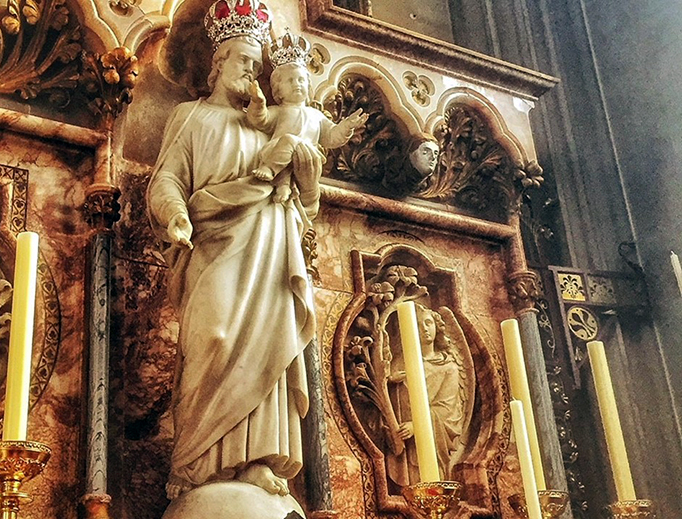Farnborough is England’s National Shrine to St. Joseph
All shall ‘go to Joseph’ to petition the Holy Patriarch

Approximately 40 minutes by train from London, there can be found Farnborough Abbey. In a side chapel in the monastery church, to the right of the high altar, stands a statute of St. Joseph. There are many statues of St. Joseph in many churches across the land. This one is different.
Farnborough Abbey in Hampshire is home to England’s National Shrine to St. Joseph. It has not always been so. In fact, for many years, the statue and the national shrine were located elsewhere. Now the statute and a nation’s devotion to St. Joseph have come to rest at St. Michael’s Abbey.
The story of St Joseph’s journey starts 151 years ago. In 1866 at Mill Hill near London, a young priest set up a Missionary Society under the patronage of St. Joseph. The priest was Herbert Vaughan, future Cardinal Archbishop of Westminster. When the chapel for the training college of the new Society was being dedicated, and having received permission from Pope Pius IX, the then Cardinal Archbishop of Westminster, Henry Manning, crowned the statue of St. Joseph.
Today, the Shrine to St. Joseph at Mill Hill is no more. In 2006 the lands and former college were sold to property developers. Farnborough Abbey was asked if it would receive the Shrine’s statue and altars. The abbot agreed to do so. And so, in 2008, the current National Shrine was erected at its present location.
It appears a straightforward tale. A statue moving from one place to another reflecting the changing times and priorities of religious communities, to say nothing of changes over the decades within English Catholicism. There is more to the story though.
When Herbert Vaughan went to try and buy the property at Mill Hill that would become the training college for his Missionary Society, the owner refused to sell. Dejected, Vaughan departed. Later, he realized that he had left a bag behind him at that property, and so returned there. He arrived to find, the owner had had a complete change of mind and agreed to the sale immediately. Vaughan was delighted. He retrieved the missing item and, bidding farewell to the owners, now sellers, of the property, left bag in hand. As he did so, he checked what was in the bag. It was a statue of St. Joseph.
During Vaughan’s fundraising endeavors he received a donation from an unexpected source. A sum of money was sent to the priest from the French Empress, Eugénie.
Soon after the Bonaparte Imperial House was exiled to England following the debacle of the Franco-Prussian War (1870). Some years later, in 1881, it was the Empress Eugénie who founded St. Michael’s Abbey, Farnborough. She installed Premonstratensians Canons there, later they were replaced with monks from the Benedictine Abbey of Solesmes in France. Initially, a statue of St. Joseph stood in the abbey sanctuary. It disappeared sometime in the 1940s, however. No one knows why or where it went. Nevertheless, it proved a curious precursor to the crowned statue that now stands once more in the sanctuary.
The more one thinks on it, though, the more a monastery seems the ideal place for a national shrine to St. Joseph. For a start, in monastic tradition, the monk has died to the world. He must keep, as St. Benedict says in Chapter 4 of the Rule, ‘death daily before his eyes’. Aptly, then, St. Joseph is the Patron of the Dying. Physical labor is an essential part of the monk’s life as it was also with one named in the Gospel as ‘the artisan’ (Mt. 13:55), St. Joseph. The life of a Benedictine monk is lived out largely in silence. History records no word from the lips of St. Joseph. The saint’s silence was not a ‘mute silence’, though, but rather a silence lived in attendance upon the Infant Word and His Mother, just as it is daily for the monk. Each member of the monastic community is called to contemplate and to sing the Word of God in the Divine Office. Here, again, the monk’s ideal could be said to be St. Joseph whose life was the contemplation of the Eternal Word and the Mother of God. Within the walls of his monastery, the monk lives enclosure. His monastery is his world. So, too, for St. Joseph, his world was at Nazareth, where he welcomed the Word in faith and adoring silence, and put himself at the service of the mystery of the Incarnation. Today, this remains the essence of the monk’s silent pilgrimage.
The English National Shrine to St. Joseph is not well-known. This was so even when the Shrine was located at Mill Hill. Now, the Shrine in its new surroundings call us away from the bustle of the cities to the Benedictine ‘Pax’ of the Abbey church and grounds of St. Michael’s Farnborough. This Shrine, increasingly, with all it recalls of the hidden life at Nazareth, will draw to it families on pilgrimage. Likewise, this will be the case, maybe more so, for men, whether husbands or fathers, old or young, lay or religious. All shall ‘go to Joseph’ (Gen. 41:55) to petition the Holy Patriarch, and to learn once more in his ‘workshop’ the value, the mystery and the truth of work, marriage, and family, and how this can only be truly understood by contemplating the Word.













